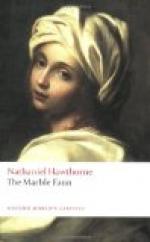The sculptor was standing at the foot of the bier, and had not yet seen the monk’s features.
“Those naked feet!” said he. “I know not why, but they affect me strangely. They have walked to and fro over the hard pavements of Rome, and through a hundred other rough ways of this life, where the monk went begging for his brotherhood; along the cloisters and dreary corridors of his convent, too, from his youth upward! It is a suggestive idea, to track those worn feet backward through all the paths they have trodden, ever since they were the tender and rosy little feet of a baby, and (cold as they now are) were kept warm in his mother’s hand.”
As his companions, whom the sculptor supposed to be close by him, made no response to his fanciful musing, he looked up, and saw them at the head of the bier. He advanced thither himself.
“Ha!” exclaimed he.
He cast a horror-stricken and bewildered glance at Miriam, but withdrew it immediately. Not that he had any definite suspicion, or, it may be, even a remote idea, that she could be held responsible in the least degree for this man’s sudden death. In truth, it seemed too wild a thought to connect, in reality, Miriam’s persecutor of many past months and the vagabond of the preceding night, with the dead Capuchin of to-day. It resembled one of those unaccountable changes and interminglings of identity, which so often occur among the personages of a dream. But Kenyon, as befitted the professor of an imaginative art, was endowed with an exceedingly quick sensibility, which was apt to give him intimations of the true state of matters that lay beyond his actual vision. There was a whisper in his ear; it said, “Hush!” Without asking himself wherefore, he resolved to be silent as regarded the mysterious discovery which he had made, and to leave any remark or exclamation to be voluntarily offered by Miriam. If she never spoke, then let the riddle be unsolved.
And now occurred a circumstance that would seem too fantastic to be told, if it had not actually happened, precisely as we set it down. As the three friends stood by the bier, they saw that a little stream of blood had begun to ooze from the dead monk’s nostrils; it crept slowly towards the thicket of his beard, where, in the course of a moment or two, it hid itself.
“How strange!” ejaculated Kenyon. “The monk died of apoplexy, I suppose, or by some sudden accident, and the blood has not yet congealed.”
“Do you consider that a sufficient explanation?” asked Miriam, with a smile from which the sculptor involuntarily turned away his eyes. “Does it satisfy you?”
“And why not?” he inquired.
“Of course, you know the old superstition about this phenomenon of blood flowing from a dead body,” she rejoined. “How can we tell but that the murderer of this monk (or, possibly, it may be only that privileged murderer, his physician) may have just entered the church?”




